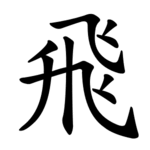Radical 183
Chinese character radical From Wikipedia, the free encyclopedia
Radical 183 or radical fly (飛部) meaning "flying" is one of the 11 Kangxi radicals out of 214 composed of 9 strokes.
| 飛 | ||
|---|---|---|
| ||
| 飛 (U+98DB) "fly" | ||
| Pronunciations | ||
| Pinyin: | fēi | |
| Bopomofo: | ㄈㄟ | |
| Wade–Giles: | fei1 | |
| Cantonese Yale: | fei1 | |
| Jyutping: | fei1 | |
| Japanese Kana: | ヒ hi (on'yomi) と-ぶ to-bu / と-ばす to-basu (kun'yomi) | |
| Sino-Korean: | 비 bi | |
| Hán-Việt: | phi, bay | |
| Names | ||
| Japanese name(s): | 飛ぶ/とぶ tobu | |
| Hangul: | 날 nal | |
| Stroke order animation | ||
 | ||

In the Kangxi Dictionary, there are 92 characters (out of 49,030) to be found under this radical.
飞, the simplified form of 飛, is the 57th indexing component in the Table of Indexing Chinese Character Components predominantly adopted by Simplified Chinese dictionaries published in mainland China, while the traditional form 飛 is listed as its associated indexing component.
Evolution
- Oracle bone script character
- Large seal script character
- Small seal script character
Derived characters
Sinogram
The radical is also used as an independent Chinese character. It is one of the Kyōiku kanji or Kanji taught in elementary school in Japan.[1] It is a fourth grade kanji.[1]
References
Literature
External links
Wikiwand - on
Seamless Wikipedia browsing. On steroids.



